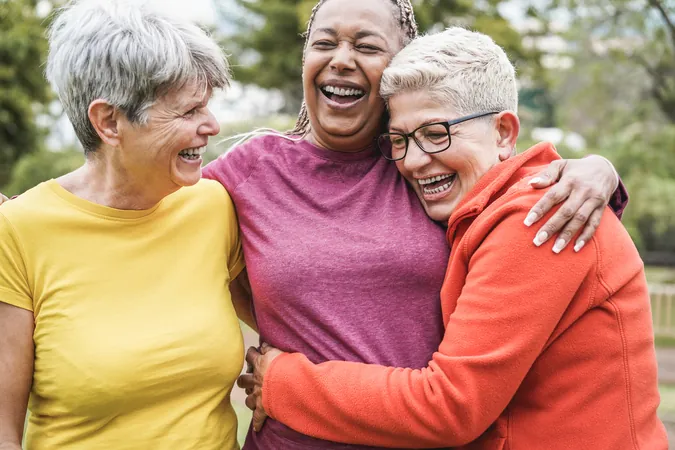
The Impact of Seasonality and Climate Change on Physical Activity Among Older Adults: What You Need to Know!
2024-10-01
The Impact of Seasonality and Climate Change on Physical Activity Among Older Adults: What You Need to Know!
As researchers delve deeper into the issue, alarming findings reveal that seasonal fluctuations in physical activity (PA) levels among older adults are largely influenced by environmental factors such as temperature and humidity. The daunting effects of climate change, characterized by an increase in extreme weather, pose significant challenges for this demographic, who often struggle to meet recommended activity guidelines.
Isabelle J. Dionne from the Université de Sherbrooke emphasizes the vital role of physical activity in maintaining the health and quality of life for older adults. Yet, despite its importance, PA levels remain disappointingly low in many developed nations. The environment in which PA is conducted has emerged as a crucial motivator for older adults to stay active, with natural settings offering a host of benefits that synthetic environments simply cannot match.
Studies show that engaging in physical activities in nature—coined ‘green PA’—is associated with enhanced feelings of revitalization, increased energy, and significant reductions in anxiety and depression. However, understanding how to promote safe and enjoyable outdoor physical activities year-round is becoming ever more critical.
Significantly, research suggests that inclement weather can reduce physical activity levels by up to 20%. For older adults, extreme temperatures and high humidity can deter participation in exercise programs, making these environmental factors key obstacles in promoting active lifestyles.
Climate Change and Its Consequences on Activity Levels
Climate change is expected to exacerbate outdoor activity challenges for older adults due to rising temperatures. Studies indicate that once temperatures hit the range of 26–29°C, participation in physical activities diminishes, exacerbated by discomfort and concerns regarding health risks. Unfortunately, projections show an increase in the number of days within this uncomfortable temperature range each year.
For older adults, hot weather can pose severe health risks, particularly because aging diminishes thermoregulation abilities. Conditions such as hypertension, diabetes, and other underlying health issues commonly arise with age and hinder the body’s ability to cope with heat. This makes it even more critical for this demographic to have a comprehensive understanding of how to practice physical activities safely.
To ensure that older adults can partake in physical activity without compromising their health, experts recommend several strategies. These include gradual, progressive activities with frequent hydration breaks and attentiveness to any symptoms of distress, such as chest pain or dizziness. It’s advisable to schedule outdoor activities during cooler parts of the day and seek shaded areas. During excessively hot days, opting for air-conditioned indoor workouts can be an effective alternative.
Winter Woes: The Battle Against Cold and Darkness
Nordic countries contend with the added challenge of harsh winters, where cardiovascular events commonly spike due to reduced physical activity levels. The combination of darkness and icy conditions during winter months can be particularly daunting for older adults. Interestingly, studies show that fear of falling is a significant deterrent for older adults wishing to engage in outdoor activities during these months, with more than 37% opting to reduce outdoor walking in winter.
However, cultures with higher winter activity levels, particularly in Scandinavian countries, demonstrate that risk perception around outdoor activities varies. Understanding these cultural differences may provide valuable insights for promoting winter physical activity among older adults.
Mitigating strategies for outdoor winter activity include layering clothing to adapt to temperature changes and using walking aids to maintain stability on icy surfaces. Group activities are also beneficial, as they foster motivation and connection among participants, especially in dreary winter weather. Additionally, virtual platforms can serve as excellent alternatives on days when conditions are less than ideal.
Looking Ahead: A Call to Action
As we contemplate the future of health and wellness for older adults, it is imperative to adapt public health messaging about physical activity to account for environmental influences. Importantly, research must explore strategies that bolster participation in physical activities amid changing climates. Simultaneously, decision-makers and community leaders must work towards creating safe, attractive outdoor spaces conducive to physical activity for older populations.
The time to act is now—ensuring that our older adults can continue to lead healthy, active lives for years to come, regardless of seasonality or climate challenges!



 Brasil (PT)
Brasil (PT)
 Canada (EN)
Canada (EN)
 Chile (ES)
Chile (ES)
 España (ES)
España (ES)
 France (FR)
France (FR)
 Hong Kong (EN)
Hong Kong (EN)
 Italia (IT)
Italia (IT)
 日本 (JA)
日本 (JA)
 Magyarország (HU)
Magyarország (HU)
 Norge (NO)
Norge (NO)
 Polska (PL)
Polska (PL)
 Schweiz (DE)
Schweiz (DE)
 Singapore (EN)
Singapore (EN)
 Sverige (SV)
Sverige (SV)
 Suomi (FI)
Suomi (FI)
 Türkiye (TR)
Türkiye (TR)